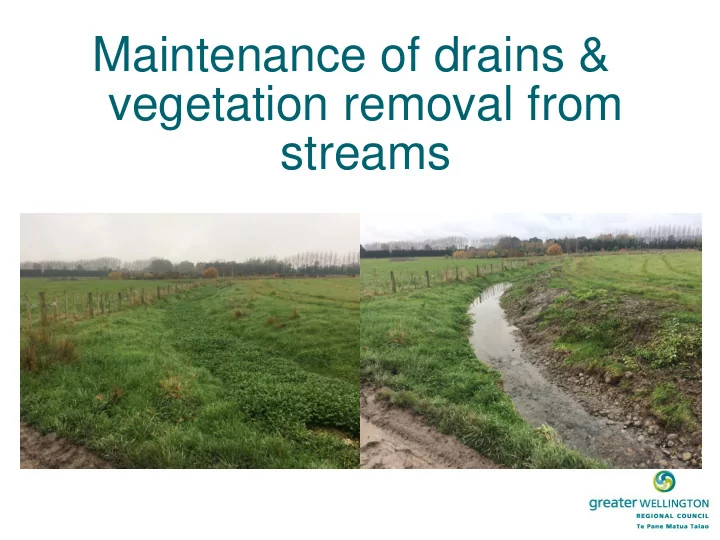

Maintenance of drains & vegetation removal from streams
Need for the rules • Weeds clog up the streams and can potentially cause flooding. • Spraying of weeds doesn’t work as it can result in the weeds coming loose and causing problems downstream (such as blocking culverts, or damming a stream). • There are occasions when people incorrectly (and at times purposefully) use the operative ‘vegetation removal’ rules to remove sediment from the stream bed. • An attempt to bring best practice into play to reduce the potential damage to existing habitats. • Further clarity on the difference between drains, highly modified waterways, and streams.
Issuesfrom the public • Uncertainty from farmers about if they have a drain or a stream – they worry about prosecution • Often farmers refer to a waterway through a farm as a “drain” when in reality it’s more than likely to be a highly modified waterway or stream. This can lead to them looking at the wrong rules in the plan. • Farmers are concerned that partial clearing doesn’t work, and their land will still flood, or that the rest of the vegetation will come loose at some stage and block culverts • Worry about prosecution if any fish are found dead. • Confusion over the wooded vegetation rule when it comes to forestry activities.
Internal considerations • GWRC groups discussing practicality of these rules (spanning many departments). • GWRC had a field day to look at the practicality of the proposed rules vs existing operations. • GWRC spent a lot of time working on definitions and rules that would allow these works as a permitted activity, with minimal effects on the environment.
Rule 121 • • Rule R121 of the PNRP allows, as a Rule 39 of the RFP provides for permitted activity, for the maintenance the removal of vegetation and any of drains, provided the conditions are associated sediment from any met. drain, for the purpose of • maintaining the original grade or The conditions for rule R121 includes the excavation of the drain to its original cross section of the channel, as a cross section, and the mechanical permitted activity. clearance of vegetation. • For the purpose of this rule, “drain” • The rule has limitations on the works means a highly modified such as time of year, amount of drain watercourse or river that is that can be cleared at one time, channelled to such an extent that it provisions for rescuing fish, location of has the characteristics of a farm spoil, the removal of wooded debris and use of weed buckets. drainage canal.
Rule 122 • • Rule 40 of the RFP provides for the Rule R122 of the PRNP provides for the trimming and removal of vegetation removal of vegetation (including weeds) from the bed of any river or lake to from the bed of any river or lake, as a avoid or mitigate flooding or erosion, or permitted activity. for the purpose of protecting structures. • This rule is more restrictive around • The conditions for this rule states no timing of year works can be undertaken, contaminants shall be released from the the use of a weed bucket, provisions for equipment, the release of sediment fish to be rescued at certain times, shall be minimized, restrictions on time restrictions on the length of wooded of year (trout spawning), restrictions on vegetation along the riverbed, and the disturbance of banded dotterels, restrictions on the amount of streambed public access shouldn’t be restricted, that can be cleared at any time. This and that all materials shall be removed rule also does not provide for the overnight and upon completion of the excavation of the stream bed. operation.
Example – Wharemauku Stream • Resource consent was applied to undertake maintenance works in the bed of tributaries of the Wharemauku Stream for: – The removal of accumulated sediment; and – Removal of vegetation
Wharemauku Stream – operative plan rules • The works will involve the removal of bed material, and the “drain” was considered a stream under the RMA and therefore they were unable to meet rule 39 or 40 of the RFP. • Under the RFP the vegetation removal will be able to meet the permitted activity standards of rule 40. • It therefore defaults to a discretionary activity under rule 49 for the removal of bed material.
Wharemauku Stream - PNRP • As the works were to be undertaken in waterbodies considered to be a “river”, and involves the removal of bed material, they were unable to meet the permitted activity standards for rule R122. • As they would be unable to meet the criteria for the minimum of 30% of the width left un-cleared (of vegetation), they were unable to meet the permitted activity standards of rule R122 for vegetation clearance. • It therefore defaults to a discretionary activity under rule R129 for vegetation clearance and bed disturbance .
General considerations • It is possible to undertake the works as a permitted activity, however these changes will likely result in additional consents being applied for. • It is encouraging best practice, and will result in less damage, disturbance and deposition in waterways. • It provides more clarity and certainty around the definitions. • If a landowner is unsure if it’s a drain, highly modified watercourse, or stream, they can just use rule R122 as its more restrictive.
Recommend
More recommend